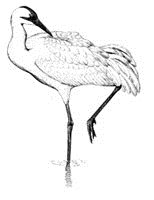North American Crane Working Group

Proceedings of the North American Crane Workshop
Date of this Version
2023
Document Type
Article
Citation
Proceedings of the North American Crane Workshop (2023) 16: 117–132
Abstract
Whooping cranes (Grus americana) frequently encounter electrical transmission or distribution lines located throughout most of their range. We estimated the probability of at least 1 whooping crane being killed by colliding with a proposed transmission line (the R-project) planned to cross the primary whooping crane migration corridor in Nebraska. We also estimated the number of individuals that might be killed by the line. We used telemetry data provided by the U.S. Geological Survey and its partners, collected from 2009 to 2018, as well as published data, to estimate: 1) the probability that a migrating whooping crane would stop within the area surrounding the planned line; 2) the probability that, if a bird stopped there, it would cross the proposed transmission line at an elevation where a collision could occur; and 3) the probability that, if exposed to a line, a fatal collision would occur. These sequential probabilities were then applied to future simulated whooping crane populations by developing a 50-year population model that we constructed in both SAS and R, then running each program 1,000 times. After 50 years, the average simulated whooping crane population in SAS and R, respectively, reached 5,157 individuals (average SD: 4,862) and 4,699 individuals (average SD: 4,455). The probability of at least 1 whooping crane being killed by colliding with the proposed line (2021–2071) was 0.63 (95% C.I. = 0.61-0.65) when results from SAS and R outputs were averaged. Among all simulations from both programs, the average number of whooping cranes killed from collisions was 1.24 (95% C.I. = 1.18-1.30). Although mortality from any one line may be minor, the collective mortality from collisions with lines located throughout a flyway might become significant.


Comments
Copyright 2025, North American Crane Working Group. Used by permission